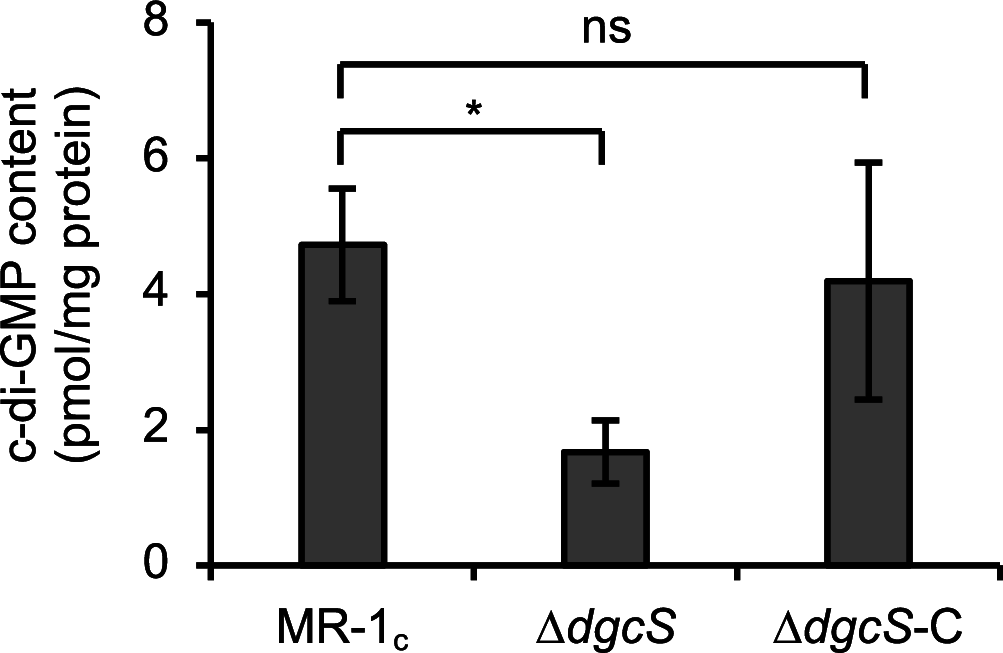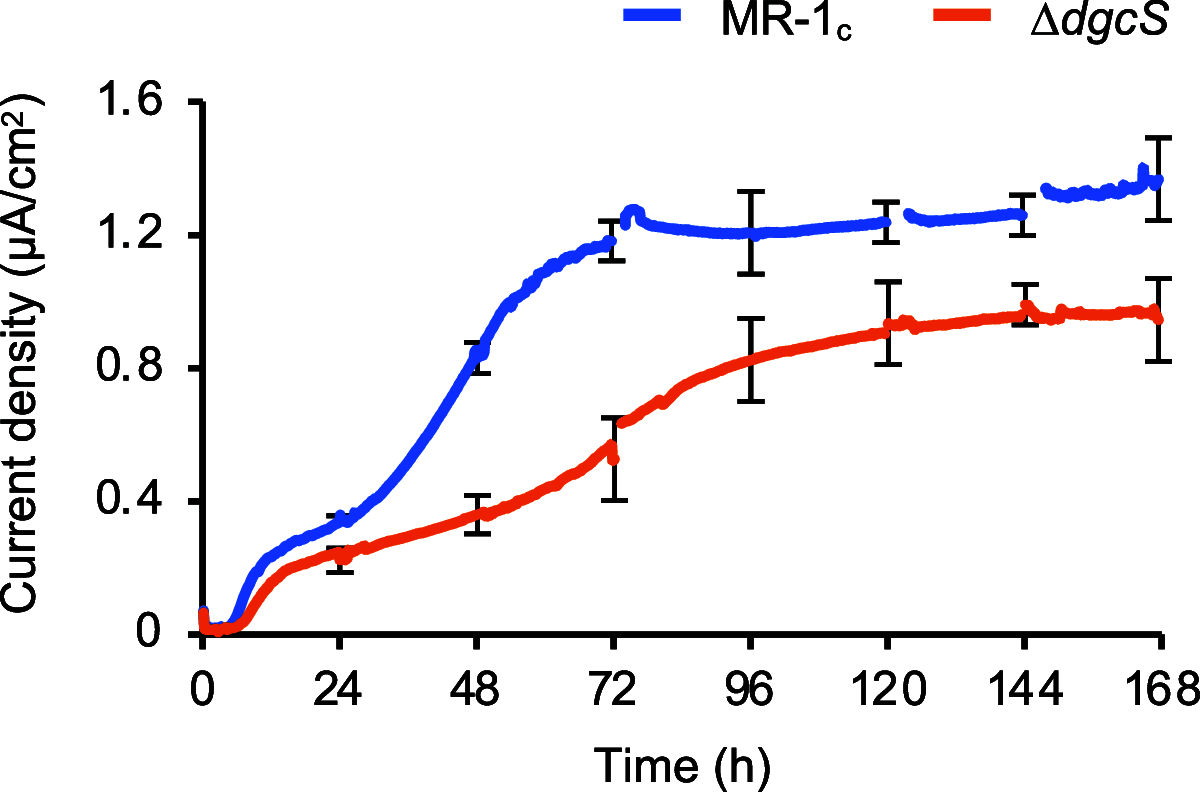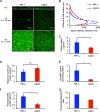Identification of a Diguanylate Cyclase That Facilitates Biofilm Formation on Electrodes by Shewanella oneidensis MR-1
- PMID: 33637573
- PMCID: PMC8091010
- DOI: 10.1128/AEM.00201-21
Identification of a Diguanylate Cyclase That Facilitates Biofilm Formation on Electrodes by Shewanella oneidensis MR-1
Abstract
In many bacteria, cyclic diguanosine monophosphate (c-di-GMP), synthesized by diguanylate cyclase (DGC), serves as a second messenger involved in the regulation of biofilm formation. Although studies have suggested that c-di-GMP also regulates the formation of electrochemically active biofilms (EABFs) by Shewanella oneidensis MR-1, DGCs involved in this process remained to be identified. Here, we report that the SO_1646 gene, hereafter named dgcS, is upregulated under medium flow conditions in electrochemical flow cells (EFCs), and its product (DgcS) functions as a major DGC in MR-1. In vitro assays demonstrated that purified DgcS catalyzed the synthesis of c-di-GMP from GTP. Comparisons of intracellular c-di-GMP levels in the wild-type strain and a dgcS deletion mutant (ΔdgcS mutant) showed that production of c-di-GMP was markedly reduced in the ΔdgcS mutant when cells were grown in batch cultures and on electrodes in EFCs. Cultivation of the ΔdgcS mutant in EFCs also revealed that the loss of DgcS resulted in impaired biofilm formation and decreased current generation. These findings demonstrate that MR-1 uses DgcS to synthesize c-di-GMP under medium flow conditions, thereby activating biofilm formation on electrodes.IMPORTANCE Bioelectrochemical systems (BESs) have attracted wide attention owing to their utility in sustainable biotechnology processes, such as microbial fuel cells and electrofermentation systems. In BESs, electrochemically active bacteria (EAB) form biofilms on electrode surfaces, thereby serving as effective catalysts for the interconversion between chemical and electric energy. It is therefore important to understand mechanisms for the formation of biofilm by EAB grown on electrodes. Here, we show that a model EAB, S. oneidensis MR-1, expresses DgcS as a major DGC, thereby activating the formation of biofilms on electrodes via c-di-GMP-dependent signal transduction cascades. The findings presented herein provide the molecular basis for improving electrochemical interactions between EAB and electrodes in BESs. The results also offer molecular insights into how Shewanella regulates biofilm formation on solid surfaces in the natural environment.
Keywords: biofilm; cyclic di-GMP; diguanylate cyclase; electrochemically active bacteria; flow cell.
Copyright © 2021 American Society for Microbiology.
Figures




Similar articles
-
Nitric oxide regulation of cyclic di-GMP synthesis and hydrolysis in Shewanella woodyi.Biochemistry. 2012 Mar 13;51(10):2087-99. doi: 10.1021/bi201753f. Epub 2012 Mar 5. Biochemistry. 2012. PMID: 22360279
-
More than Enzymes That Make or Break Cyclic Di-GMP-Local Signaling in the Interactome of GGDEF/EAL Domain Proteins of Escherichia coli.mBio. 2017 Oct 10;8(5):e01639-17. doi: 10.1128/mBio.01639-17. mBio. 2017. PMID: 29018125 Free PMC article.
-
Indirect modulation of the intracellular c-Di-GMP level in Shewanella oneidensis MR-1 by MxdA.Appl Environ Microbiol. 2011 Mar;77(6):2196-8. doi: 10.1128/AEM.01985-10. Epub 2011 Jan 28. Appl Environ Microbiol. 2011. PMID: 21278272 Free PMC article.
-
Molecular mechanisms regulating the catabolic and electrochemical activities of Shewanella oneidensis MR-1.Biosci Biotechnol Biochem. 2021 Jun 24;85(7):1572-1581. doi: 10.1093/bbb/zbab088. Biosci Biotechnol Biochem. 2021. PMID: 33998649 Review.
-
Diguanylate Cyclases in Vibrio cholerae: Essential Regulators of Lifestyle Switching.Front Cell Infect Microbiol. 2020 Oct 22;10:582947. doi: 10.3389/fcimb.2020.582947. eCollection 2020. Front Cell Infect Microbiol. 2020. PMID: 33194821 Free PMC article. Review.
Cited by
-
Dynamic synthesis and transport of phenazine-1-carboxylic acid to boost extracellular electron transfer rate.Nat Commun. 2025 Mar 25;16(1):2882. doi: 10.1038/s41467-025-57497-z. Nat Commun. 2025. PMID: 40128539 Free PMC article.
-
Comparative Genomics Revealing Insights into Niche Separation of the Genus Methylophilus.Microorganisms. 2021 Jul 24;9(8):1577. doi: 10.3390/microorganisms9081577. Microorganisms. 2021. PMID: 34442656 Free PMC article.
-
Enhanced depolluting capabilities of microbial bioelectrochemical systems by synthetic biology.Synth Syst Biotechnol. 2023 May 25;8(3):341-348. doi: 10.1016/j.synbio.2023.05.005. eCollection 2023 Sep. Synth Syst Biotechnol. 2023. PMID: 37275577 Free PMC article.
-
Applications of Synthetic Biotechnology on Carbon Neutrality Research: A Review on Electrically Driven Microbial and Enzyme Engineering.Front Bioeng Biotechnol. 2022 Jan 25;10:826008. doi: 10.3389/fbioe.2022.826008. eCollection 2022. Front Bioeng Biotechnol. 2022. PMID: 35145960 Free PMC article. Review.
-
Towards Application of Electro-Fermentation for the Production of Value-Added Chemicals From Biomass Feedstocks.Front Chem. 2022 Jan 19;9:805597. doi: 10.3389/fchem.2021.805597. eCollection 2021. Front Chem. 2022. PMID: 35127650 Free PMC article. Review.
References
-
- Rabaey K, Angenent L, Schroder U, Keller J (ed). 2009. Bioelectrochemical systems: from extracellular electron transfer to biotechnological application. International Water Association, London, United Kingdom.
-
- Borole AP, Reguera G, Ringeisen B, Wang Z-W, Feng Y, Kim BH. 2011. Electroactive biofilms: current status and future research needs. Energy Environ Sci 4:4813–4813. 10.1039/c1ee02511b. - DOI
Publication types
MeSH terms
Substances
Supplementary concepts
LinkOut - more resources
Full Text Sources
Other Literature Sources

